Comparison of Microbially Induced Healing Solutions for Crack Repairs of Cement-Based Infrastructure
Abstract
:1. Introduction
1.1. Terminology of (Self-)Healing and Repair in the Context of Available Options for Service Life Increase
1.2. Different Approaches to (Self-)Healing and Repair with Focus on Bacteria-Based Solutions
2. Comparison of Efficacy of Selected Healing Solutions
2.1. Compressive Strength Recovery Improvement
- CSRI is compressive strength recovery improvement (%);
- CSVs.a.t is compressive strength value of the sample after treatment (with external agent) or after curing (being previously pre-cracked, in the case of internal agents);
- CSVb.a.u.h is compressive strength value of plain mix (blank) after the period of unassisted healing—in case of external agents these are the non-treated samples, and in the case of internal agents these are the plain mix (blank) samples;
- CSVb.und is the reference compressive strength value, i.e., the compressive strength value of non-treated undamaged plain mix (blank) sample.
2.2. Comparison of Required Volume of Repair Solutions
2.3. Capillary Water Absorption Reduction
3. Conclusions
Author Contributions
Funding
Institutional Review Board Statement
Informed Consent Statement
Data Availability Statement
Acknowledgments
Conflicts of Interest
References
- Sidiq, A.; Gravina, R.; Giustozzi, F. Is concrete healing really efficient? A review. Constr. Build. Mater. 2019, 205, 257–273. [Google Scholar] [CrossRef]
- Zhang, W.; Zheng, Q.; Ashour, A.; Han, B. Self-healing cement concrete composites for resilient infrastructures: A review. Compos. Part B Eng. 2020, 189, 107892. [Google Scholar] [CrossRef]
- Olivier, J.G.J.; Janssens-Maenhout, G.; Muntean, M.; Peters, J.A.H.W. Trends in Global CO2 Emissions—2016 Report. 2016. Available online: https://edgar.jrc.ec.europa.eu/news_docs/jrc-2016-trends-in-global-co2-emissions-2016-report-103425.pdf (accessed on 11 February 2021).
- Sidiq, A.; Setunge, S.; Gravina, R.J.; Giustozzi, F. Self-repairing cement mortars with microcapsules: A microstructural evaluation approach. Constr. Build. Mater. 2020, 232, 117239. [Google Scholar] [CrossRef]
- Kim, H.; Tae, S.; Ahn, Y.; Yang, J. Scenarios for Life Cycle Studies of Bridge Concrete Structure Maintenance. Sustainability 2020, 12, 9557. [Google Scholar] [CrossRef]
- Sangadji, S. Can Self-healing Mechanism Helps Concrete Structures Sustainable? Procedia Eng. 2017, 171, 238–249. [Google Scholar] [CrossRef]
- Mengel, L.; Krauss, H.-W.; Lowke, D. Water transport through cracks in plain and reinforced concrete—Influencing factors and open questions. Constr. Build. Mater. 2020, 254, 118990. [Google Scholar] [CrossRef]
- BSI. Eurocode 2: Design of Concrete Structures—Part 1: General Rules and Rules For Buildings—(Together with United Kingdom National Application Document); British Standards Institution: London, UK, 1992. [Google Scholar]
- ACI Committee 318. Building Code Requirements for Structural Concrete; American Concrete Institute: Farmington Hills, MI, USA, 2014. [Google Scholar]
- BSI. Eurocode 2: Design of Concrete Structures—Part 2: Concrete Bridges—Design and Detailing Rules (BS EN 1992-2:2005); British Standards Institution: London, UK, 2005. [Google Scholar]
- Li, K.; Li, L. Crack-altered durability properties and performance of structural concretes. Cem. Concr. Res. 2019, 124, 1–11. [Google Scholar] [CrossRef]
- Tuutti, K. Corrosion of Steel in Concrete; Swedish Cement and Concrete Research Institute: Stockholm, Sweden, 1982. [Google Scholar]
- Käthler, A.C.B.; Angst, U.M.; Wagner, M.; Larsen, C.K.; Elsener, B. Effect of Cracks on Chloride-Induced Corrosion of Steel in Concrete—A Review; Norwegian Public Roads Administration: Oslo, Norway, 2017.
- Angst, U. Durable Concrete Structures: Cracks & Corrosion and Corrosion & Cracks. In Proceedings of the 10th International Conference on Fracture Mechanics of Concrete and Concrete Structures; Pijaudier-Cabot, G., Grassl, P., La Borderie, C., Eds.; International Association for Fracture Mechanics of Concrete and Concrete Structures: Bayonne, France, 2019. [Google Scholar]
- De Belie, N.; Gruyaert, E.; Al-Tabbaa, A.; Antonaci, P.; Baera, C.; Bajare, D.; Darquennes, A.; Davies, R.; Ferrara, L.; Jefferson, T.; et al. A Review of Self-Healing Concrete for Damage Management of Structures. Adv. Mater. Interfaces 2018, 5, 1–28. [Google Scholar] [CrossRef]
- Reddy, T.C.S.; Ravitheja, A. Macro mechanical properties of self-healing concrete with crystalline admixture under different environments. Ain Shams Eng. J. 2019, 10, 23–32. [Google Scholar] [CrossRef]
- Heide, N.T.; Schlangen, E. Selfhealing of early age cracks in concrete. In Proceedings of the First International Conference on Self-Healing Materials, Noordwijk aan Zee, The Netherlands, 18–20 April 2007. [Google Scholar]
- Hearn, N. Self-sealing, autogenous healing and continued hydration: What is the difference? Mater. Struct. 1998, 31, 563–567. [Google Scholar] [CrossRef]
- Teall, O.R. Crack Closure and Enhanced Autogenous Healing of Structural Concrete Using Shape Memory Polymers; Cardiff University: Cardiff, UK, 2016. [Google Scholar]
- Wang, R.; Yu, J.; Gu, S.; He, P.; Han, X.; Liu, Q. Investigation of self-healing capability on surface and internal cracks of cement mortar with ion chelator. Constr. Build. Mater. 2020, 236, 117598. [Google Scholar] [CrossRef]
- Li, G.; Liu, S.; Niu, M.; Liu, Q.; Yang, X.; Deng, M. Effect of granulated blast furnace slag on the self-healing capability of mortar incorporating crystalline admixture. Constr. Build. Mater. 2020, 239, 117818. [Google Scholar] [CrossRef]
- Stanaszek-Tomal, E. Bacterial Concrete as a Sustainable Building Material? Sustainability 2020, 12, 696. [Google Scholar] [CrossRef] [Green Version]
- Nayanthara, P.G.N.; Dassanayake, A.B.N.; Nakashima, K.; Kawasaki, S. Microbial Induced Carbonate Precipitation Using a Native Inland Bacterium for Beach Sand Stabilization in Nearshore Areas. Appl. Sci. 2019, 9, 3201. [Google Scholar] [CrossRef] [Green Version]
- Vucetic, S.; Miljevic, B.; Sovljanski, O.; Van Der Bergh, J.M.; Markov, S.; Hirsenberger, H.; Malesevic, M.T.; Ranogajec, J. Functional mortars for conservation of cultural heritage structures. IOP Conf. Ser. Mater. Sci. Eng. 2020, 949, 12091. [Google Scholar] [CrossRef]
- Al-Salloum, Y.; Hadi, S.; Abbas, H.; Almusallam, T.; Moslem, M. Bio-induction and bioremediation of cementitious composites using microbial mineral precipitation—A review. Constr. Build. Mater. 2017, 154, 857–876. [Google Scholar] [CrossRef]
- Gomez, M.G.; Anderson, C.M.; Graddy, C.M.R.; DeJong, J.T.; Nelson, D.C.; Ginn, T.R. Large-Scale Comparison of Bioaugmentation and Biostimulation Approaches for Biocementation of Sands. J. Geotech. Geoenviron. Eng. 2017, 143, 04016124. [Google Scholar] [CrossRef]
- Sovljanski, O.; Pezo, L.; Tomic, A.; Ranitovic, A.; Cvetkovic, D.; Markov, S. Operating parameter optimization of cell surface hydrophobicity test for ureolytic bacteria. J. Serbian Chem. Soc. 2020, 82. [Google Scholar] [CrossRef]
- Pang, H.; Wang, G.; Yang, H.; Wu, H.; Wang, X.; Chen, Y. Identification of Ureolytic Bacteria for Concrete Formation and Antifungal Activity from the Soil with Long-Term Application of Urea Fertilizer. IOP Conf. Ser. Earth Environ. Sci. 2019, 252, 052131. [Google Scholar] [CrossRef] [Green Version]
- Andreolli, M.; Lampis, S.; Bernardi, P.; Calò, S.; Vallini, G. Bacteria from black crusts on stone monuments can precipitate CaCO3 allowing the development of a new bio-consolidation protocol for ornamental stone. Int. Biodeterior. Biodegrad. 2020, 153, 105031. [Google Scholar] [CrossRef]
- Jimenez-Lopez, C.; Rodriguez-Navarro, C.; Piñar, G.; Carrillo-Rosúa, F.; Rodriguez-Gallego, M.; Gonzalez-Muñoz, M. Consolidation of degraded ornamental porous limestone stone by calcium carbonate precipitation induced by the microbiota inhabiting the stone. Chemosphere 2007, 68, 1929–1936. [Google Scholar] [CrossRef] [Green Version]
- Stocks-Fischer, S.; Galinat, J.K.; Bang, S.S. Microbiological precipitation of CaCO3. Soil Biol. Biochem. 1999, 31, 1563–1571. [Google Scholar] [CrossRef]
- Portugal, C.R.M.E.; Fonyo, C.; Machado, C.C.; Meganck, R.; Jarvis, T. Microbiologically Induced Calcite Precipitation biocementation, green alternative for roads—is this the breakthrough? A critical review. J. Clean. Prod. 2020, 262, 121372. [Google Scholar] [CrossRef]
- Choi, S.-G.; Wang, K.; Wen, Z.; Chu, J. Mortar crack repair using microbial induced calcite precipitation method. Cem. Concr. Compos. 2017, 83, 209–221. [Google Scholar] [CrossRef]
- Manzur, T.; Huq, R.S.; Efaz, I.H.; Afroz, S.; Rahman, F.; Hossain, K. Performance enhancement of brick aggregate concrete using microbiologically induced calcite precipitation. Case Stud. Constr. Mater. 2019, 11, e00248. [Google Scholar] [CrossRef]
- Omoregie, A.I.; Ngu, L.H.; Ong, D.E.L.; Nissom, P.M. Low-cost cultivation of Sporosarcina pasteurii strain in food-grade yeast extract medium for microbially induced carbonate precipitation (MICP) application. Biocatal. Agric. Biotechnol. 2019, 17, 247–255. [Google Scholar] [CrossRef] [Green Version]
- Wang, Y.; Soga, K.; DeJong, J.T.; Kabla, A.J. Microscale Visualization of Microbial-Induced Calcium Carbonate Precipitation Processes. J. Geotech. Geoenvironmental Eng. 2019, 145, 04019045. [Google Scholar] [CrossRef]
- Zhang, J.; Zhao, C.; Zhou, A.; Yang, C.; Zhao, L.; Li, Z. Aragonite formation induced by open cultures of microbial consortia to heal cracks in concrete: Insights into healing mechanisms and crystal polymorphs. Constr. Build. Mater. 2019, 224, 815–822. [Google Scholar] [CrossRef]
- Phillips, A.J.; Gerlach, R.; Lauchnor, E.; Mitchell, A.C.; Cunningham, A.B.; Spangler, L. Engineered applications of ureolytic biomineralization: A review. Biofouling 2013, 29, 715–733. [Google Scholar] [CrossRef] [PubMed] [Green Version]
- Vijay, K.; Murmu, M.; Deo, S.V. Bacteria based self-healing concrete—A review. Constr. Build. Mater. 2017, 152, 1008–1014. [Google Scholar] [CrossRef]
- Jafarnia, M.S.; Saryazdi, M.K.; Moshtaghioun, S.M. Use of bacteria for repairing cracks and improving properties of concrete containing limestone powder and natural zeolite. Constr. Build. Mater. 2020, 242, 118059. [Google Scholar] [CrossRef]
- Joshi, S.; Goyal, S.; Mukherjee, A.; Reddy, M.S. Microbial healing of cracks in concrete: A review. J. Ind. Microbiol. Biotechnol. 2017, 44, 1511–1525. [Google Scholar] [CrossRef]
- Gupta, S.; Kua, H.W.; Pang, S.D. Healing cement mortar by immobilization of bacteria in biochar: An integrated approach of self-healing and carbon sequestration. Cem. Concr. Compos. 2018, 86, 238–254. [Google Scholar] [CrossRef]
- Jongvivatsakul, P.; Janprasit, K.; Nuaklong, P.; Pungrasmi, W.; Likitlersuang, S. Investigation of the crack healing performance in mortar using microbially induced calcium carbonate precipitation (MICP) method. Constr. Build. Mater. 2019, 212, 737–744. [Google Scholar] [CrossRef]
- Chunxiang, Q.; Jianyun, W.; Ruixing, W.; Liang, C. Corrosion protection of cement-based building materials by surface deposition of CaCO3 by Bacillus pasteurii. Mater. Sci. Eng. C 2009, 29, 1273–1280. [Google Scholar] [CrossRef]
- Kaur, N.P.; Majhi, S.; Dhami, N.K.; Mukherjee, A. Healing fine cracks in concrete with bacterial cement for an advanced non-destructive monitoring. Constr. Build. Mater. 2020, 242, 118151. [Google Scholar] [CrossRef]
- Van Der Bergh, J.M.; Miljević, B.; Šovljanski, O.; Vučetić, S.; Markov, S.; Ranogajec, J.; Bras, A. Preliminary approach to bio-based surface healing of structural repair cement mortars. Constr. Build. Mater. 2020, 248, 118557. [Google Scholar] [CrossRef]
- Abo-El-Enein, S.; Ali, A.; Talkhan, F.N.; Abdel-Gawwad, H. Utilization of microbial induced calcite precipitation for sand consolidation and mortar crack remediation. HBRC J. 2012, 8, 185–192. [Google Scholar] [CrossRef] [Green Version]
- Sánchez, M.; Faria, P.; Ferrara, L.; Horszczaruk, E.; Jonkers, H.; Kwiecień, A.; Mosa, J.; Peled, A.; Pereira, A.; Snoeck, D.; et al. External treatments for the preventive repair of existing constructions: A review. Constr. Build. Mater. 2018, 193, 435–452. [Google Scholar] [CrossRef] [Green Version]
- BSI. Products and Systems for the Protection and Repair of Concrete Structures—Definitions, Requirements, Quality Control and Evaluation of Conformity (BS EN 1504-10:2017); British Standards Institution: London, UK, 2017. [Google Scholar]
- Shamsuddoha, M.; Hüsken, G.; Schmidt, W.; Kühne, H.-C.; Baeßler, M. Ternary mix design of grout material for structural repair using statistical tools. Constr. Build. Mater. 2018, 189, 170–180. [Google Scholar] [CrossRef]
- Mirza, J.; Saleh, K.; Langevin, M.-A.; Mirza, S.; Bhutta, M.A.R.; Tahir, M.M. Properties of microfine cement grouts at 4°C, 10°C and 20 °C. Constr. Build. Mater. 2013, 47, 1145–1153. [Google Scholar] [CrossRef]
- Somarathna, H.; Raman, S.; Mohotti, D.; Mutalib, A.; Badri, K. The use of polyurethane for structural and infrastructural engineering applications: A state-of-the-art review. Constr. Build. Mater. 2018, 190, 995–1014. [Google Scholar] [CrossRef]
- Issa, C.A.; Debs, P. Experimental study of epoxy repairing of cracks in concrete. Constr. Build. Mater. 2007, 21, 157–163. [Google Scholar] [CrossRef]
- Bader, T.; Lackner, R. Acrylic surface treatment applied to architectural High-Performance Concrete (HPC): Identification of potential pitfalls on the way to long-lasting protection. Constr. Build. Mater. 2020, 237, 117415. [Google Scholar] [CrossRef]
- Song, X.; Wei, J.; He, T. A method to repair concrete leakage through cracks by synthesizing super-absorbent resin in situ. Constr. Build. Mater. 2009, 23, 386–391. [Google Scholar] [CrossRef]
- Shen, L.; Jiang, H.; Wang, T.; Chen, K.; Zhang, H. Performance of silane -based surface treatments for protecting degraded historic concrete. Prog. Org. Coatings 2019, 129, 209–216. [Google Scholar] [CrossRef]
- Ferrara, L.; Van Mullem, T.; Alonso, M.C.; Antonaci, P.; Borg, R.P.; Cuenca, E.; Jefferson, A.; Ng, P.-L.; Peled, A.; Roig-Flores, M.; et al. Experimental characterization of the self-healing capacity of cement based materials and its effects on the material performance: A state of the art report by COST Action SARCOS WG2. Constr. Build. Mater. 2018, 167, 115–142. [Google Scholar] [CrossRef] [Green Version]
- De Nardi, C.; Bullo, S.; Ferrara, L.; Ronchin, L.; Vavasori, A. Effectiveness of crystalline admixtures and lime/cement coated granules in engineered self-healing capacity of lime mortars. Mater. Struct. 2017, 50, 191. [Google Scholar] [CrossRef]
- Khushnood, R.A.; Qureshi, Z.A.; Shaheen, N.; Ali, S. Bio-mineralized self-healing recycled aggregate concrete for sustainable infrastructure. Sci. Total Environ. 2020, 703, 135007. [Google Scholar] [CrossRef] [PubMed]
- Rooij, M.; van Tittelboom, K.; Belie, N.; Schlangen, E. Self-Healing Phenomena in Cement-Based Materials: State-of-the-Art Report of RILEM Technical Committee. In State-of-the-Art Report of RILEM Technical Committee 221-SHC: Self-Healing Phenomena in Cement-Based Materials; Springer: Dordrecht, The Netherlands, 2013. [Google Scholar]
- BSI. Methods of Test for Mortar for Masonry, Part 11 Determination of Flexural Compressive Strength Hardened Mortar (EN 1015-18:2002); British Standards Institution: London, UK, 2002. [Google Scholar]
- ASTM C1585-13. Standard Test Method for Measurement of Rate of Absorption of Water by Hydraulic Cement Concretes; ASTM International: West Conshohocken, PA, USA, 2013; pp. 1–6. [Google Scholar]
- AlGhamri, R.; Al-Tabbaa, A. Self-healing of cracks in mortars using novel PVA-coated pellets of different expansive agents. Constr. Build. Mater. 2020, 254, 119254. [Google Scholar] [CrossRef]
- Vaezi, M.; Zareei, S.A.; Jahadi, M. Recycled microbial mortar: Effects of bacterial concentration and calcium lactate content. Constr. Build. Mater. 2020, 234, 117349. [Google Scholar] [CrossRef]
- Mohammed, H.; Ortoneda-Pedrola, M.; Nakouti, I.; Bras, A. Experimental characterisation of non-encapsulated bio-based concrete with self-healing capacity. Constr. Build. Mater. 2020, 256, 119411. [Google Scholar] [CrossRef]
- Erşan, Y.Ç.; Hernandez-Sanabria, E.; Boon, N.; de Belie, N. Enhanced crack closure performance of microbial mortar through nitrate reduction. Cem. Concr. Compos. 2016, 70, 159–170. [Google Scholar] [CrossRef]
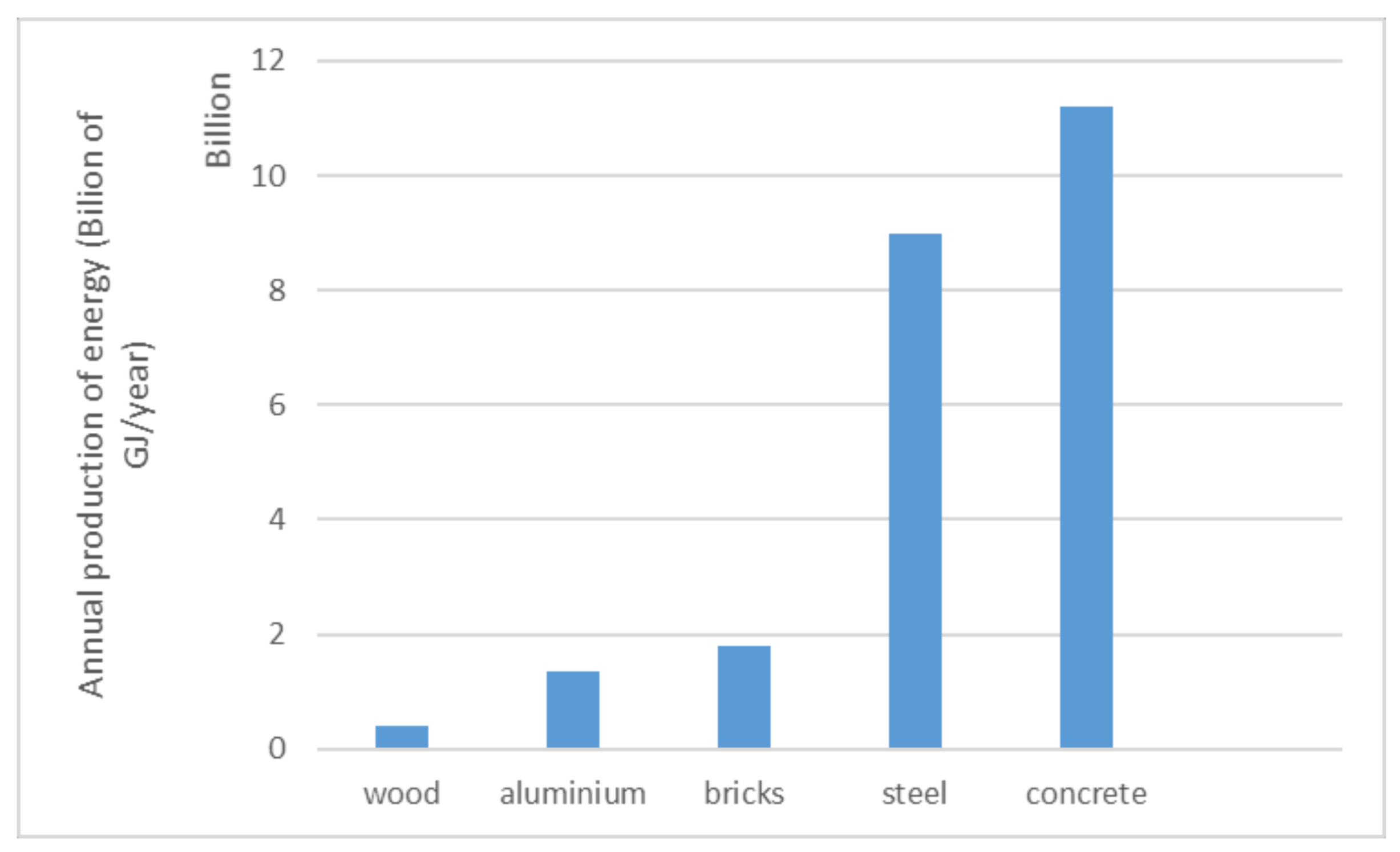
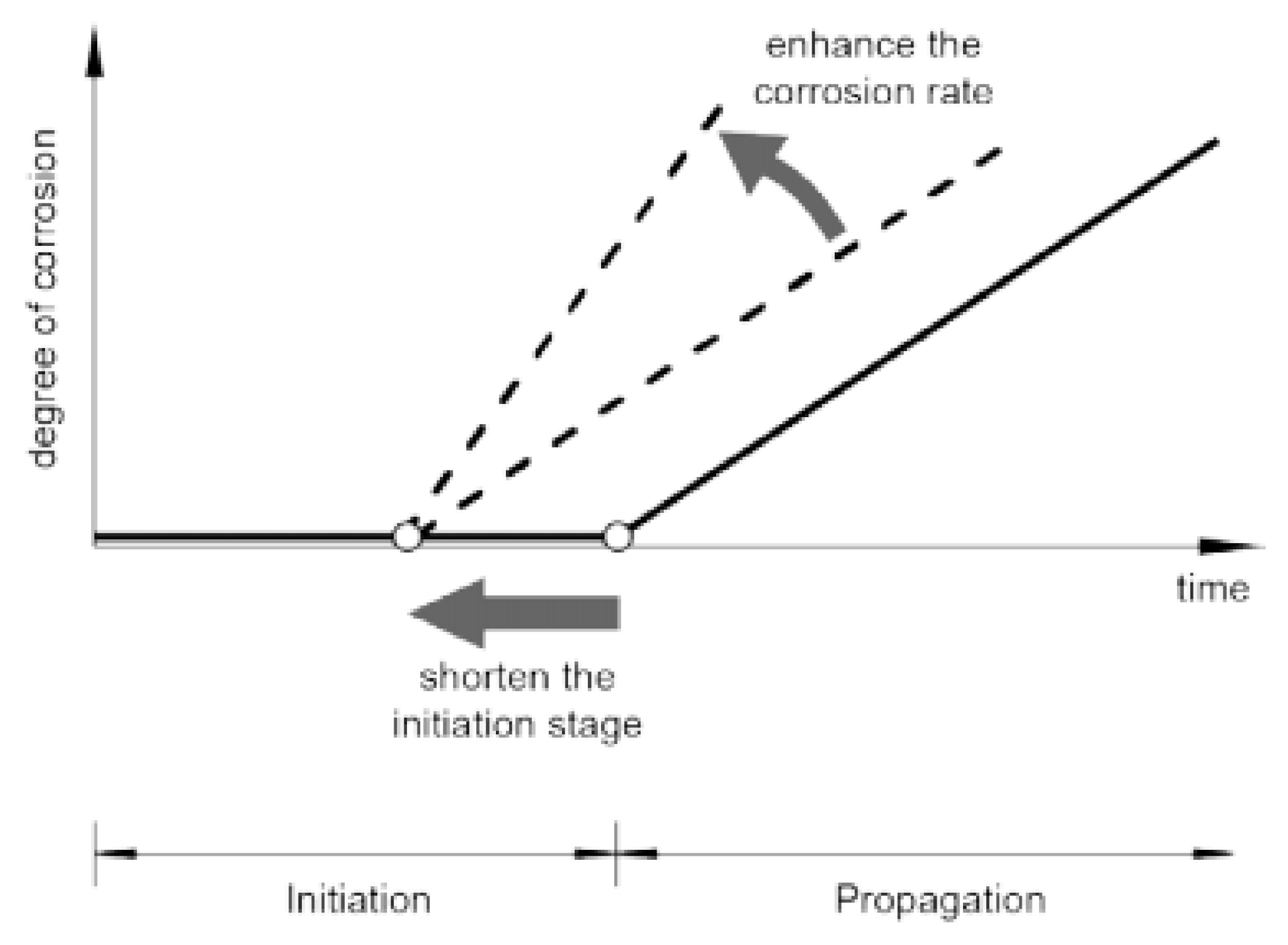


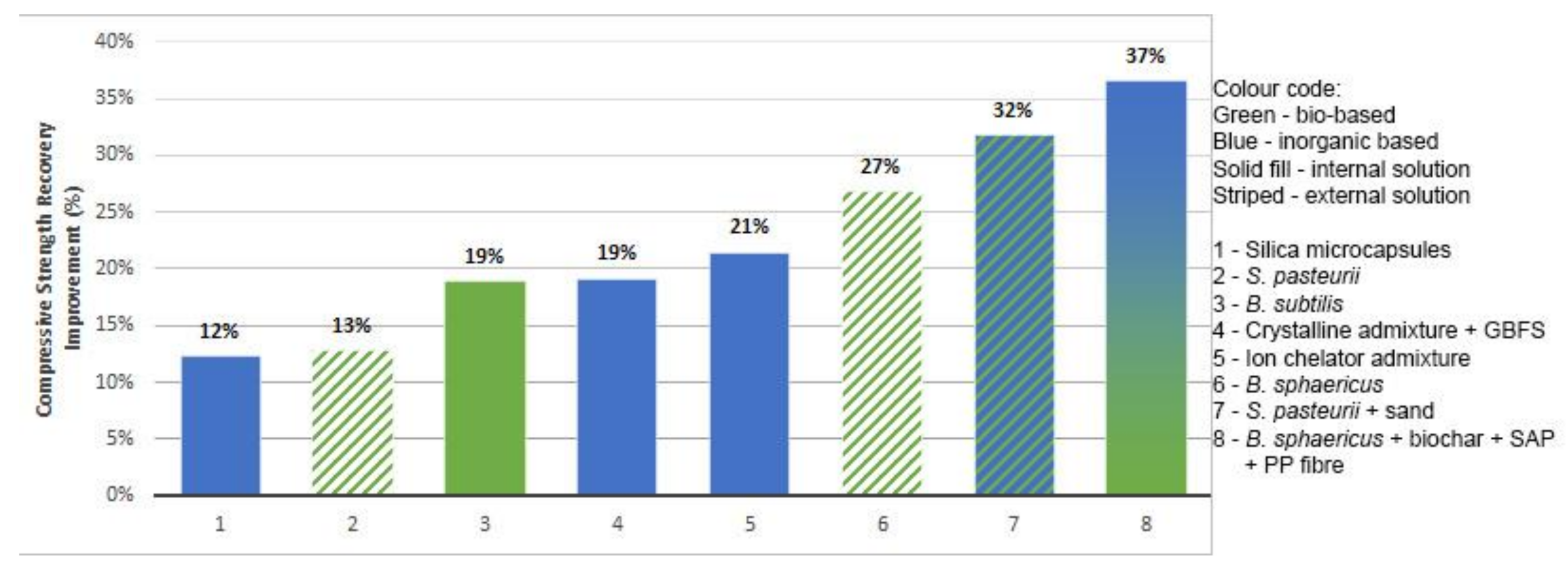
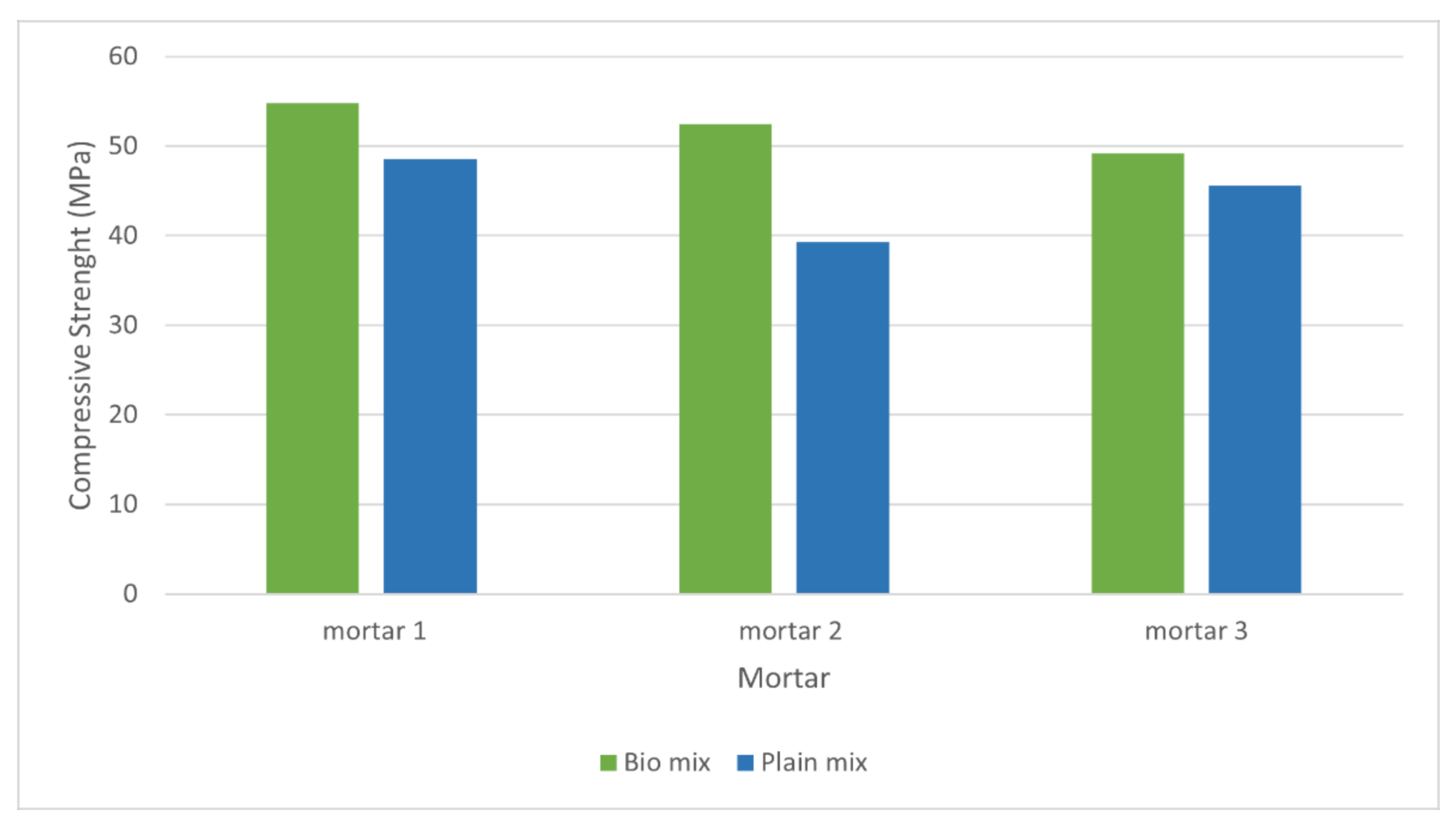
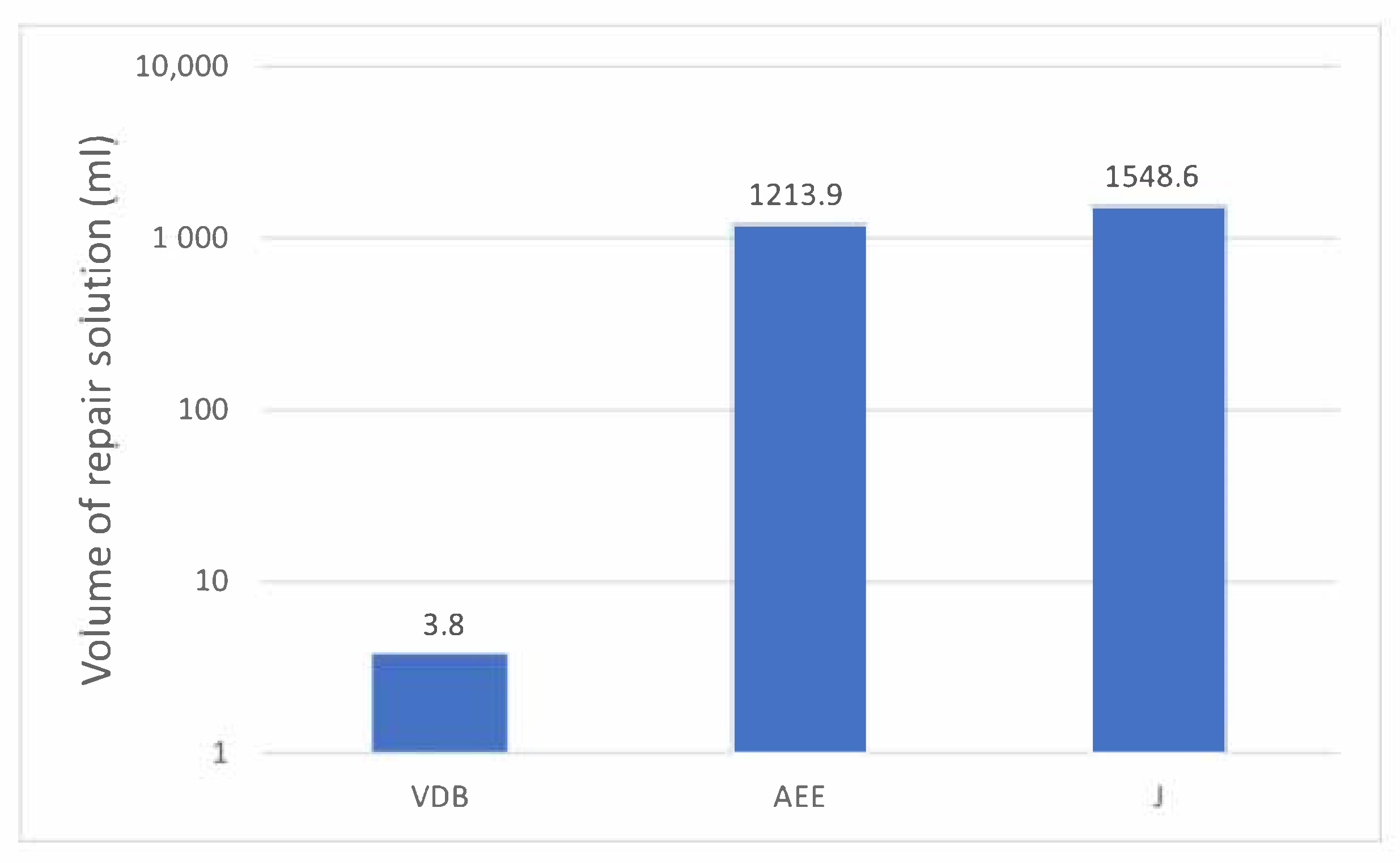


| No. in Figure 5 | Authors | Type of Solution | Solution Based on | Curing Time | Pre-Loading Force (of max.) |
|---|---|---|---|---|---|
| 1 | Sidiq et al. (2020) [4] | Internal | Sodium silica microcapsules | 28 days | 70% |
| 2 | Van der Bergh et al. (2020) [46] | External | Sporosarcina pasteurii | 28 days | To failure |
| 3 | Khushnood et al. (2020) [59] | Internal | Bacillus subtilis | 28 days | 85% |
| 4 | Li et al. (2020) [21] | Internal | Penetron Admix® crystalline admixture + granulated blast furnace slag | 28 days | To failure |
| 5 | Wang et al. (2020) [20] | Internal | Ion chelator crystalline admixture | 21 days | 60% |
| 6 | Jongvivatsakul et al. (2019) [43] | External | Bacillus sphaericus | 20 days | N/a |
| 7 | Abo-El-Enein et al. (2012) [47] | External | Sporosarcina pasteurii + sand | 28 days | N/a |
| 8 | Gupta et al. (2018) [42] | Internal | Bacillus sphaericus + biochar + superabsorbent polymer + polypropylene fibres | 21 days | 50% |
Publisher’s Note: MDPI stays neutral with regard to jurisdictional claims in published maps and institutional affiliations. |
© 2021 by the authors. Licensee MDPI, Basel, Switzerland. This article is an open access article distributed under the terms and conditions of the Creative Commons Attribution (CC BY) license (https://creativecommons.org/licenses/by/4.0/).
Share and Cite
van der Bergh, J.M.; Miljević, B.; Vučetić, S.; Šovljanski, O.; Markov, S.; Riley, M.; Ranogajec, J.; Bras, A. Comparison of Microbially Induced Healing Solutions for Crack Repairs of Cement-Based Infrastructure. Sustainability 2021, 13, 4287. https://doi.org/10.3390/su13084287
van der Bergh JM, Miljević B, Vučetić S, Šovljanski O, Markov S, Riley M, Ranogajec J, Bras A. Comparison of Microbially Induced Healing Solutions for Crack Repairs of Cement-Based Infrastructure. Sustainability. 2021; 13(8):4287. https://doi.org/10.3390/su13084287
Chicago/Turabian Stylevan der Bergh, John Milan, Bojan Miljević, Snežana Vučetić, Olja Šovljanski, Siniša Markov, Mike Riley, Jonjaua Ranogajec, and Ana Bras. 2021. "Comparison of Microbially Induced Healing Solutions for Crack Repairs of Cement-Based Infrastructure" Sustainability 13, no. 8: 4287. https://doi.org/10.3390/su13084287
APA Stylevan der Bergh, J. M., Miljević, B., Vučetić, S., Šovljanski, O., Markov, S., Riley, M., Ranogajec, J., & Bras, A. (2021). Comparison of Microbially Induced Healing Solutions for Crack Repairs of Cement-Based Infrastructure. Sustainability, 13(8), 4287. https://doi.org/10.3390/su13084287










